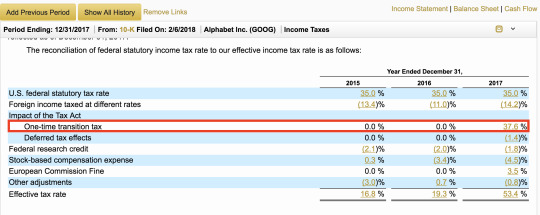Now that annual reports for 2017 are arriving in larger numbers, we’re starting to see more analysis of how tax reform will affect corporate taxes. One interesting item: thanks to the one-time tax on unrepatriated cash held overseas, some companies will see their effective tax rates for 2017 actually increase.
A prime example is Google, which filed its Form 10-K on Feb. 6. Google expects to pay $10.2 billion for that one-time tax. Combined with all the other taxes, credits, and deductions that Google usually claims, that will push its effective tax rate way up — from 19.3 percent in 2016 to 53.4 percent in 2017. See cool reconciliation chart, below.

Now, as the phrase “one-time transition tax” suggests, Google will pay this tax only one time. Presumably Google’s effective tax rate will return to “normal” in 2018, which seems to be somewhere around 16 to 21 percent in recent years. Indeed, its effective rate might even fall to lower levels, since the new statutory rate will be 21 percent and companies will work hard to go down from there. We’ve already set a calendar alert to check again in 12 months.
Lockheed Martin, which also filed its 10-K this week, is another example. The company reported an additional tax expense of $43 million on “deemed repatriated earnings” of $435 million. Combined with downward adjustments to some deferred tax assets Lockheed had on the books, that pushed its effective tax rate from 23.2 percent in 2016 to 63.4 percent this year.

Calculating what corporations “really pay” in taxes is notoriously difficult. All filers are required to reconcile their actual tax payments back to the statutory rate (35 percent through 2017, 21 percent from 2018 forward) — but some companies report dollar amounts, others use percentages, and some report both.
Calcbench did examine tax reconciliation among the S&P 500 last year, and found that average tax rate paid by the group over the last five years was 22.8 percent. Some had actual tax rates below zero, others rates considerably above the statutory 35 percent.
Bottom line: effective tax rates and tax reconciliation are tricky business. In this first year of tax reform, we’re likely to see some strange-looking numbers out there — but they only look strange. Use Calcbench to dig deeper, and you can follow the logic eventually.
**Psst…professional subscribers, yes, you. You can dive a level deeper! Here’s a link to learn more.